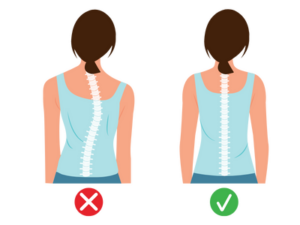
Exercise Your Way To Better Posture
In this article, we’ll discuss what posture is, why it’s important, and the best exercises to include in your workout for posture improvement.
First, what is posture and why is it important?
Posture refers to how your body holds itself—primarily when standing, but also in sitting or even lying positions.
What are the effects of good posture?
Having a strong, well-balanced body promotes movement efficiency and endurance, contributes to an overall feeling of well being, and projects poise confidence and dignity.
- Movement Efficiency: A strong, well-balanced body requires less energy to move, allowing for greater endurance in daily activities.
- Confidence and Appearance: Standing tall with good posture projects confidence and self-assurance.
- Injury Prevention: Poor posture can increase the risk of injury due to muscle imbalances and mechanical stress on joints and ligaments.
What are the effects of poor posture?
With a weak, imbalanced body where your bones are not properly aligned, your muscles, joints, and ligaments take more strain than nature intended.
Over time, this can lead to a variety of health issues, including:
- Back pain
- Muscle fatigue
- Rounded shoulders
- General body aches
It is also important to keep in mind that you are at a much higher risk of injury when your muscles are weak.
Additionally, poor posture can affect the position and function of your vital organs, particularly those in the abdominal region. making it a serious concern for long-term health.
So, how can you work your way to better posture?
By choosing the right forms of exercise you can significantly improve your posture.
Does Working Out Really Fix Your Posture?
- Stronger muscles in your neck and back will hold your head erect and your shoulder blades close together.
- By maintaining strength in your abdominal and leg muscles, you can better align your spine and pelvis.
- This makes it easier for you to hold your body in a more upright position.
What Is The Best Workout For Posture?
The best workout for improving posture combines exercises that strengthen core muscles, increase flexibility, and correct muscle imbalances.
Here’s a breakdown of what to include:
- Back strengthening
- Core strengthening
- Leg strengthening
- Shoulder mobility and strength
- Hip flexor and chest stretches
- Posture-correcting movements
This combination helps improve posture by addressing strength, flexibility, and mobility.
Key Postural Alignment Exercises
Techniques to restore your posture include stretching and exercises that focus on strengthening the muscles of the neck, back, abdomen and legs.
— Strengthening Exercises
Strengthening exercises are essential for improving the muscles responsible for holding your body upright.
1) Neck and Back Strengthening
- Purpose: Strengthening the muscles in your neck and back helps keep your head erect and shoulder blades close together, providing a stable upper body.
- Examples: Chin Tucks, Rows, Superman
2) Core and Abdominal Strengthening
- Purpose: Strong abdominal muscles provide support for your spine and pelvis, ensuring better alignment from the base.
- Examples: Planks, Dead Bug, Pelvic Tilts
3) Leg Strengthening
- Purpose: Strengthening your leg muscles helps support your pelvis and lower back, contributing to overall body alignment.
- Examples: Squats, lunges
— Stretching Exercises
Stretching helps to release tension in tight muscles, which can pull your body out of alignment.
1) Chest and Shoulder Stretches
- Purpose: Helps reduce the forward rounding of the shoulders, a common issue with poor posture.
- Examples: Doorway Stretch, Overhead Reach
2) Hip Flexor Stretches
- Purpose: Tight hip flexors can pull your pelvis forward, leading to poor posture. Stretching them helps correct this imbalance.
- Examples: Lunge Stretch, Kneeling Hip Flexor Stretch, Pigeon Pose
3) Hamstring Stretches
- Purpose: Tight hamstrings can contribute to a rounded lower back. Stretching them can improve your lower body alignment.
- Examples: Seated Hamstring Stretch, Forward Fold (Standing), Dynamic Leg Swings
Tips for Daily Movement
Even simple daily activities such as sitting at your desk or bending over can result in an injury.
Here are some routine ways you can improve your posture:
- Engage your core: Whether you’re walking, sitting, or lifting, keep your core muscles engaged to support your spine.
- Check your posture: Periodically check your posture throughout the day, especially if you’re sitting for long periods.
- Use ergonomic tools: Adjust your desk, chair, and monitor to promote better posture and reduce strain on your back and neck.
To help you achieve the best possible posture, our physical therapists at The Jackson Clinics can show you movement patterns and positions to ensure good posture throughout all your activities.
Customized Exercise Programs for Posture
Good posture is critical to all that you do, so it is important that you perform the right exercises to correct and sustain body alignment.
While general exercise routines may help, working with a physical therapist (PT) ensures that you’re addressing your unique postural issues in a safe and effective manner.
At The Jackson Clinics, our physical therapists have extensive knowledge of the spine and muscles, allowing them to identify your postural problems and to prescribe exercises to correct them.
They have the expertise to:
- Assess Your Posture: Physical Therapists perform detailed evaluations of your body alignment, identifying imbalances and areas of weakness that contribute to poor posture.
- Provide Customized Programs: Instead of a one-size-fits-all approach, we can provide a customized program tailored to your specific needs to strengthen your back and have your body position in proper alignment.
- Focus on Both Strengthening and Stretching: Physical therapists understand the importance of a balanced approach to address tight muscles and weak areas. This combination helps you build a strong foundation for long-term posture improvement and injury prevention.
- Offer Guidance and Support: A PT will ensure that you’re performing exercises correctly, reducing the risk of injury. They also provide ongoing feedback and adjustments to your program as your posture improves.
With expert guidance from our physical therapists, you can achieve lasting improvements in your posture, which will enhance movement efficiency, reduce pain, and help prevent future issues.
Did you know you have Direct Access* to Physical Therapy? No referral, no problem!
Want more content from TJC? Check us out on Facebook!
The Jackson Clinics serves 18 locations throughout Northern Virginia.
Find one near you: https://thejacksonclinics.com/locations/

















